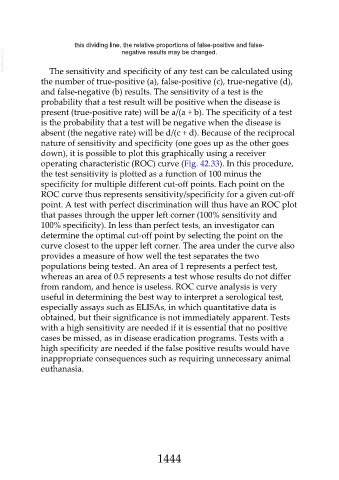Page 1444 - Veterinary Immunology, 10th Edition
P. 1444
this dividing line, the relative proportions of false-positive and false-
VetBooks.ir
negative results may be changed.
The sensitivity and specificity of any test can be calculated using
the number of true-positive (a), false-positive (c), true-negative (d),
and false-negative (b) results. The sensitivity of a test is the
probability that a test result will be positive when the disease is
present (true-positive rate) will be a/(a + b). The specificity of a test
is the probability that a test will be negative when the disease is
absent (the negative rate) will be d/(c + d). Because of the reciprocal
nature of sensitivity and specificity (one goes up as the other goes
down), it is possible to plot this graphically using a receiver
operating characteristic (ROC) curve (Fig. 42.33). In this procedure,
the test sensitivity is plotted as a function of 100 minus the
specificity for multiple different cut-off points. Each point on the
ROC curve thus represents sensitivity/specificity for a given cut-off
point. A test with perfect discrimination will thus have an ROC plot
that passes through the upper left corner (100% sensitivity and
100% specificity). In less than perfect tests, an investigator can
determine the optimal cut-off point by selecting the point on the
curve closest to the upper left corner. The area under the curve also
provides a measure of how well the test separates the two
populations being tested. An area of 1 represents a perfect test,
whereas an area of 0.5 represents a test whose results do not differ
from random, and hence is useless. ROC curve analysis is very
useful in determining the best way to interpret a serological test,
especially assays such as ELISAs, in which quantitative data is
obtained, but their significance is not immediately apparent. Tests
with a high sensitivity are needed if it is essential that no positive
cases be missed, as in disease eradication programs. Tests with a
high specificity are needed if the false positive results would have
inappropriate consequences such as requiring unnecessary animal
euthanasia.
1444

